This Day in History… August 22, 1970
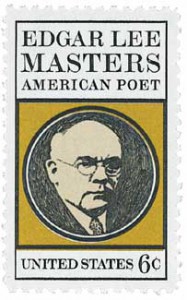
On August 22, 1970, the US Post Office issued the first stamp in the American Poet Series.
Prior to this series, there had been a relatively small number of stamps honoring American poets. Most notably, five poets were honored in 1940 as part of the Famous Americans Series – Henry Wadsworth Longfellow, John Greenleaf Whittier, James Russell Lowell, Walt Whitman, and James Whitcomb Riley. Other poets previously honored on stamps included Edgar Allan Poe and Francis Scott Key.
The 1970 series was the result of a campaign launched by the Academy of American Poets. In announcing the new series, the postmaster general stated that “President Nixon has shown considerable interest in our stamp program, and I agree with him that there is a place on our stamps also for those quiet men and women of genius whose endeavors have preserved our heritage and contributed to our cultural stimulation.”

The first stamp in the series honored Edgar Lee Masters. Originally it was going to be issued on his 101st birthday, but as that fell on a Sunday, they held the ceremony a day early, on August 22, 1970. The ceremony was held in Petersburg, Illinois, where Masters lived until the age of 11. His childhood home was restored and turned into a museum.

Born in Garnett, Kansas, Masters grew up in Petersburg, Illinois. He wrote novels, poetry, plays, biography, and history. Masters is chiefly remembered for his Spoon River Anthology, a collection of 200 poems in free verse. Spoon River is an imaginary midwestern village, and each poem of the anthology is “spoken” by a deceased former resident of the town, providing a revealing look at the secret lives of small-town America. Each of the dead speakers attempts to illuminate the meaning of life on Earth.
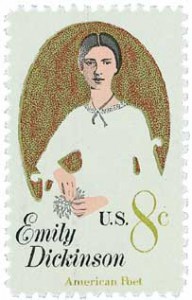
The American Poet Series continued in 1971 with a stamp honoring Emily Dickinson. The stamp was issued on August 28, in Amherst, Massachusetts, where Dickinson had lived from 1830 to 1886. The stamp ceremony was part of a three-day celebration of Dickinson’s life.
Emily Dickinson is believed to have written 1,800 poems during her lifetime. However, she only allowed seven of her poems to be published and insisted they be published anonymously. Much of her work deals with death and immortality. The first complete collection of her poetry became available for the first time in 1955, with the publication of The Poems of Emily Dickinson.
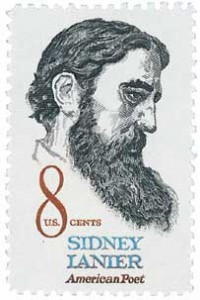
Sidney Lanier joined the series on February 3, 1972 which was his 130th birthday. The stamp was issued in his hometown of Macon, Georgia. Lanier was noted for writing about the beauty of the American South. A musician as well as a poet, he was well known for his ability to adapt musical meter to poetry. Many in the South called him the “poet of the Confederacy.”
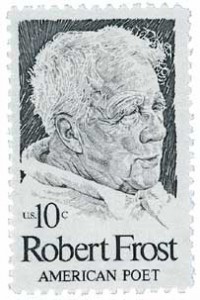
The series continued in 1974 with a stamp honoring Robert Frost. The stamp was issued on his 100th birthday – March 26, 1974 – in Derry, New Hampshire, where Frost lived for nine years and produced some of his best-loved poems. The graceful, plain-language poems were inspired by New England’s beauty, landscapes, folkways, and speech patterns. Frost won the Pulitzer Prize for poetry four times. He also received a gold medal from Congress and was the first poet to read at a presidential inauguration.
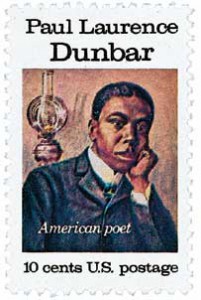
Paul Laurence Dunbar joined the series on May 1, 1975. The stamp was issued in Dayton, Ohio, where he grew up. Dunbar began writing at an early age and was one of the first African American writers to earn international fame. He was one of the most popular American poets of the 1890s and early 1900s. Dunbar published 12 books between 1896 and 1905 – more than any black American until 1950. His writing greatly contributed to a more sensitive understanding of African Americans.
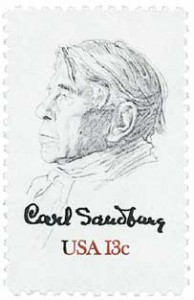
A stamp honoring Carl Sandburg was added to the series on January 6, 1978, his 100th birthday. The stamp was issued at his birthplace in Galesburg, Illinois. Despite his lack of education, Sandburg earned acclaim as the “Workingman’s Poet” during his lifetime. His verse reflected his own life experiences and spoke to the average American. He eventually received three honorary college degrees and won three Pulitzer Prizes.
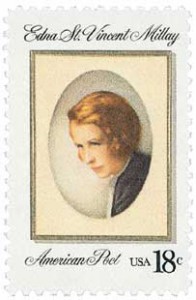
The final stamp in the series honoring Edna St. Vincent Millay was issued on July 10, 1981, in Austerlitz, New York, where she spent her final years. Millay began writing significant poetry at a very young age. Her well-known poem “Renascence” was written when she was just 19 years old. In 1923, she won a Pulitzer Prize for poem “The Ballad of the Harp-Weaver.”
A definitive collection of her poems was published in 1956.
Click here to see what else happened on This Day in History.

Mystic, thank you for your continued efforts with “This Day in History.” I appreciate your reminders to all of us about the historical values of our hobby.
I’d appreciate an article now and again about the artists who designed noted stamps. Any interesting lives? Controversies?
Interesting that Joyce Kilmer never made it to a stamp. His poem “Trees” is an American classic. He has a Memorial Forest in Western North Carolina but no stamp that I can recall.
Good point, Dale.
I loved reading this article about the series of Poets in stamps. I now have a better appreciation for these stamps. In the 2nd paragraph, you did neglect to name the post master general who announced the series, but no big deal.